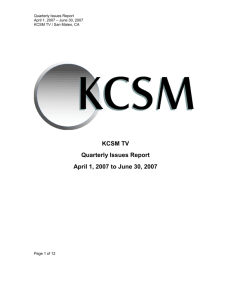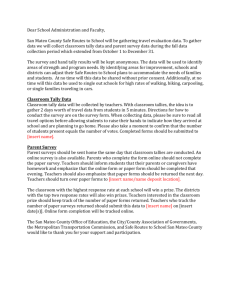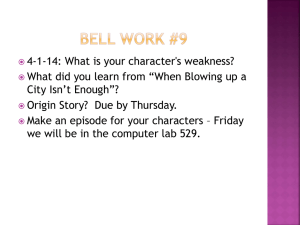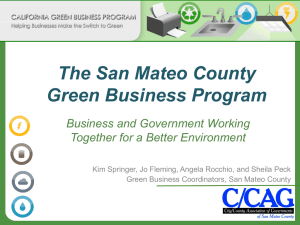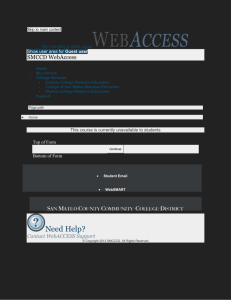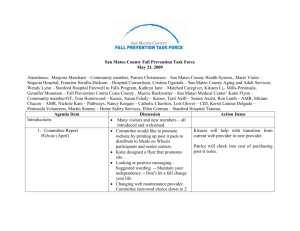Fourth Quarter 2007
advertisement
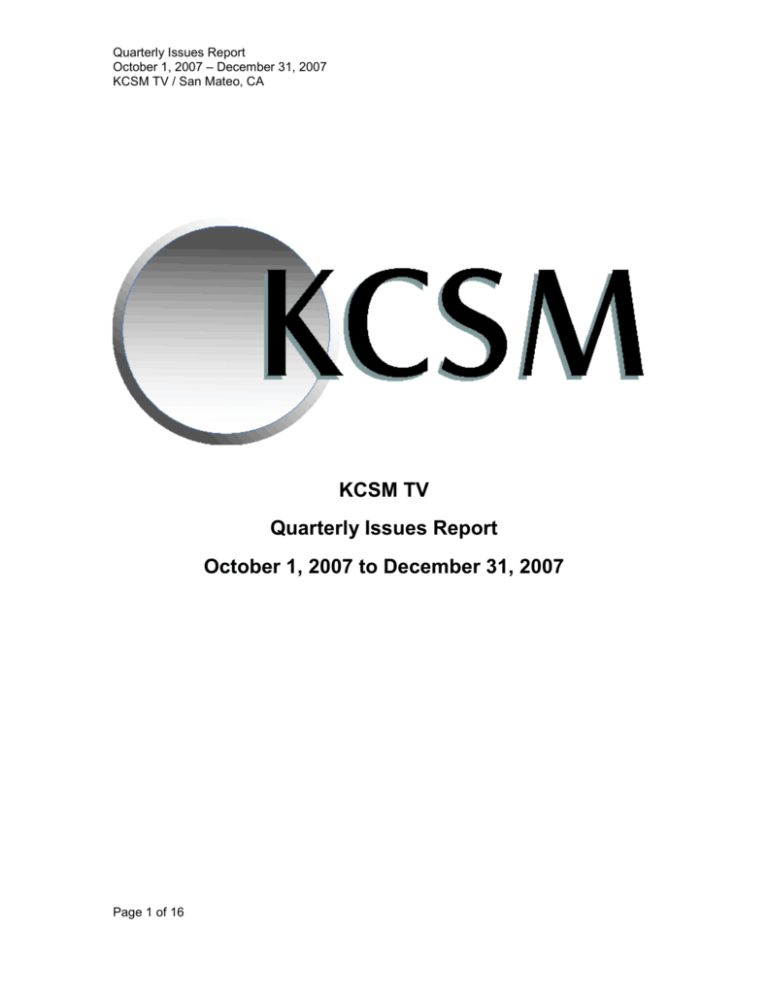
Quarterly Issues Report October 1, 2007 – December 31, 2007 KCSM TV / San Mateo, CA KCSM TV Quarterly Issues Report October 1, 2007 to December 31, 2007 Page 1 of 16 Quarterly Issues Report October 1, 2007 – December 31, 2007 KCSM TV / San Mateo, CA The licensee of station KCSM-TV has determined the following issues were of importance to the San Mateo County and San Francisco Bay Area communities during the past three month and has aired the following programs listed below which address these issues. Education & Children’s Programming Minorities Senior & Family Issues Public Safety, Health & Welfare Politics / Government Page 2 of 16 Quarterly Issues Report October 1, 2007 – December 31, 2007 KCSM TV / San Mateo, CA 1. Education Earth Revealed: Introductory Geology This series shows the physical processes and human activities that shape our planet. From earthquakes and volcanoes to the creation of sea-floor crusts and shifting river courses, Earth Revealed offers stunning visuals that explain plate tectonics and other geologic concepts and principles. Follow geologists in the field as they explore the primal forces of the Earth. This series can also be used as a resource for teacher professional development. 1. Down to Earth Surface conditions of the planets Venus and Mars are compared with those of Earth, and scenes of Earth's living landscapes lead into a discussion of how unique Earth truly is. Major topics addressed in the series, including plate tectonics, natural resources, seismology, and erosion, are introduced in this program. 2. The Restless Planet Early Greek astronomers believed that Earth was the center of the universe. However, this notion changed dramatically over time, especially after the invention of the telescope. This program traces the development of astronomical theory with discussions of the discoveries of Copernicus, Galileo, Kepler, and Newton. Unique characteristics of Earth are also discussed. 3. Earth's Interior Oil wells do more than just produce oil — they serve as windows to Earth’s interior. This program introduces the topic of geophysics, exploring methods of studying what lies beneath Earth’s surface. Geophysicists use seismic wave studies, variations in temperature, magnetic fields, gravity, and computer simulations to create models of deep structures. 4. The Sea Floor The mysteries of the ocean floor lie hidden under enormous pressure and total darkness. This program looks at the research submersibles and indirect methods used to study the bottom of the sea, providing a glimpse of volcanic activity, formations such as the continental shelf and midocean ridges, and life forms that thrive at extreme depths. 5. The Birth of a Theory In the 1960s, earth scientists developed the theory of plate tectonics. This program traces the development of plate tectonics, beginning with the contributions and methods of geologist Alfred Wegener. Sea-floor spreading, continental drift, paleomagnetism, and the primordial supercontinent Pangaea are some of the topics covered. 6. Plate Dynamics This program examines the movement and interaction of tectonic plates, which account for a vast array of geologic formations and phenomena — from California’s San Andreas Fault to the Rift Valley of eastern Africa. The program covers convergent boundaries, subduction, hotspots, and the debate over what drives plate motion. Page 3 of 16 Quarterly Issues Report October 1, 2007 – December 31, 2007 KCSM TV / San Mateo, CA 7. Mountain Building This program erodes the myth of the mountain as a solid, permanent structure. Animations are used to illustrate the process of orogeny (mountain building) through accretion and erosion, as well as the role of plate tectonics, the rock cycle, and how different types of rock are formed in the course of mountain building. 8. Earth's Structures A visit to the Grand Canyon lays the foundation for this exploration of rock layers and deformation. The program covers sedimentation, major structures, the methods used to examine them, and how petroleum may be trapped inside them. It also looks at tectonic force and the different types of stress involved in the formation of geologic structures. 9. Earthquakes Showing actual footage of earthquakes and their aftermath, this program discusses the forces that fuel these massive events. Faults, waves, and the transfer of energy from the epicenter are explained, and histories of the seismograph and Richter scale are presented. The program also describes devices being developed to study — and eventually predict — earthquakes. 10. Geologic Time To illustrate the immensity of geologic time, the entire span of Earth’s existence is compressed down to a year. The timeline of major geologic events is superimposed onto the year for a condensed view of Earth’s evolution. A relationship between this timeline and that of life on Earth is established, with fossils and radiocarbon dating playing a major role in the discovery. 11. Evolution Through Time The fossil record reveals much about the diversity and development of species. This program examines the traces left by early plants, animals, and single-celled organisms and follows the progression of life forms over time. Connections are drawn between atmospheric gases, climate change, rock formation, biological functions, and mass extinctions. 12. Minerals: The Materials of Earth Minerals have been indispensable to human civilization. This program looks at the variety of minerals, their atomic and crystalline structures, and their physical properties such as hardness and luster. Petrologists’ methods of sectioning rocks are shown, and gems, precious metals, ore excavation, and the value of silicates are discussed. 13. Volcanism Volcanoes provide clues about what is going on inside Earth. Animations illustrate volcanic processes and how plate boundaries are related to volcanism. The program also surveys the various types of eruptions, craters, cones and vents, lava domes, magma, and volcanic rock. The 1980 eruption of Mount St. Helens serves as one example. 14. Intrusive Igneous Rocks Most magma does not extrude onto Earth’s surface but cools slowly deep inside Earth. This magma seeps into crevices in existing rock to form intrusive igneous rocks. Experts provide a Page 4 of 16 Quarterly Issues Report October 1, 2007 – December 31, 2007 KCSM TV / San Mateo, CA graphic illustration of this process and explain the types and textures of rocks such as granite, obsidian, and quartz. Once again, plate tectonics is shown to be involved in the process. 15. Weathering and Soils The Cleopatra’s Needle obelisk in New York City’s Central Park is severely weathered after only 75 years, whereas the dry climate of Egypt has preserved similar structures in that country for millennia. This program shows how weather, climate, chemicals, temperature, and type of substrate factor into rock and soil erosion. Environmental connections are also considered. 16. Mass Wasting Anyone undertaking a building project must understand mass wasting — the downslope movement of earth under the influence of gravity. Various factors in mass wasting, including the rock’s effective strength and pore spaces, are discussed, as are different types of mass wasting such as creep, slump, and landslides. Images of an actual landslide illustrate the phenomenon. 17. Sedimentary Rocks: The Key to Past Environments This program returns to the Grand Canyon: its exposed layers of sedimentary rock allow scientists to peer into the geologic past. The movement of sediment and its deposition are covered, and the processes of lithification, compaction, and cementation that produce sedimentary rocks are explained. Organic components of rock are also discussed. 18. Metamorphic Rocks The weight of a mountain creates enough pressure to recrystallize rock, thus creating metamorphic rocks. This program outlines the recrystallization process and the types of rock it can create — from claystone and slate to schist and garnet-bearing gneiss. The relationship of metamorphic rock to plate tectonics is also covered. 19. Running Water I: Rivers, Erosion and Deposition Rivers are the most common land feature on Earth and play a vital role in the sculpting of land. This program shows landscapes formed by rivers, the various types of rivers, the basic parts of a river, and how characteristics of rivers — their slope, channel, and discharge — erode and build the surrounding terrain. Aspects of flooding are also discussed. 20. Running Water II: Landscape Evolution The Colorado River is a powerful geologic agent — powerful enough to have carved the Grand Canyon. This program focuses on how such carving takes place over time, looking at erosion and deposition processes as they relate to river characteristics and type of rock. The evolution of rivers is covered, along with efforts to prevent harmful consequences to humans. 21. Groundwater Approximately three-quarters of Earth’s surface is covered by water. But most fresh water comes from underground. Topics of this program include aquifers, rock porosity and permeability, artesian wells, the water table, cave formation, sinkholes, and how groundwater may become contaminated. Page 5 of 16 Quarterly Issues Report October 1, 2007 – December 31, 2007 KCSM TV / San Mateo, CA 22. Wind, Dust and Deserts Land in arid climates is shaped in particular ways. This program shows how deserts are defined by infrequent precipitation and how desertification relates to proximity to the equator, proximity to mountains, and ultimately plate tectonics. Images of landscapes illustrate how wind creates features such as dunes, playas, blow-outs, and even oases. 23. Glaciers Many of the world’s most beautiful landscapes were made by glaciers. This program shows how, explaining glacial formation, structure, movement, and methods of gouging and accumulating earth. The program provides images of glaciers and glacial landforms such as moraines, and discusses how study of glaciers may help us understand ice ages and the greenhouse effect. 24. Waves, Beaches and Coasts This program shows the dynamic interaction of two geologic agents: rocky landmasses and the energy of the ocean. Aspects of waves — their types, parts, movement, and impact on the shore — are illustrated. The program also covers shoreline characteristics, currents, sea barriers, tides, and how the greenhouse effect could impact sea level and coastal lands. 25. Living With Earth, Part I Scenes of San Francisco before the Loma Prieta earthquake introduce this program addressing how humans are learning to cope with earthquakes. Various groups and agencies are studying the San Andreas Fault and the damage caused along its path to better understand how earthquakes ravage the land. Methods of studying earthquakes are reviewed. 26. Living With Earth, Part II Since the nineteenth century, humans have turned to the Earth for energy sources to fuel their industry. This program discusses where oil comes from, how it is extracted, and how it is converted into energy. The effects of oil drilling and the burning of fossil fuels are also addressed, and the potential of alternative energy sources is considered. This series is taught as a college level course and is available to college and advanced level high school students. Mondays 6 am 26 episodes Length: 30 minutes each Way We Live: Introduction to Sociology The Way We Live is a comprehensive introduction to Sociology distance learning course that blends all the attributes of broadcast-quality video with the best-selling textbooks Sociology and Society: The Basics (Macionis); a course study guide; a faculty guide with exam bank; and optional online components in HTML and WebCT format. Page 6 of 16 Quarterly Issues Report October 1, 2007 – December 31, 2007 KCSM TV / San Mateo, CA 22 half-hour video lessons address core topics, correlate directly to the course textbooks, and provide the context for learning. Real-world examples in each video, called Slice of Life focus on real people and issues and foster better understanding of key concepts. Let your students explore the rich tapestry, diversity, and commonality of the human experience; learn to think critically about the challenging issues of our time; and develop a solid understanding of the groups, organizations, and societies which form the contexts for …“ the way we live.” Supporting print materials (sold separately): Textbook Option 1: Sociology, 11th Edition by Macionis. 2007. ISBN-10: 0132184745. ISBN-13: 978013218474Chapter 16 Textbook Option 2: Society: The Basics, 9th Edition by Macionis. 2007. ISBN-10: 0132284901. ISBN-13: 9780132284905Chapter 12 Study Guide: The Way We Live: Distance Learning Study Guide, by Stephen Light, PH.D., SUNY Plattsburgh. Publisher: Prentice Hall, Phone:(800) 526-0484, Fax: (614) 841-3690 website: http://vig.prenhall.com/home Faculty Guide with Exam Bank: 1st Edition, 2006. Available from INTELECOM. Online Component: Available in HTML and WebCT formats. This series is taught as a college level course and is available to college and advanced level high school students. Tuesdays 6 am 26 episodes Length: 30 minutes each Berenstain Bears The Berenstain Bears are a fictional family of anthropomorphic bears created by Stan and Jan Berenstain in a series of very popular children's books. The popularity of the books subsequently spawned numerous child-friendly television shows and computer games. The family consists of Papa Bear, the woodworker father; Mama Bear, his homemaker wife; and their three children: Brother Bear, Sister Bear, and Honey Bear. Stories are set in Bear Country, a society comprised totally of bears. Story lines typically follow the Bear family as they deal with topics relevant to both children and parents. Each Bear's role in the family was well defined. Brother, being the oldest sibling, was controlling and protective of Sister while also being more cautious in his manner. Sister, being the younger sibling, was more laid-back, energetic and free spirited. Mama typically was the source of wisdom and knowledge. Papa, while also being wise at times, was more bumbling and clumsy in his demeanor. Over 300 Berenstain Bears books have been published since the 1960s. Page 7 of 16 Quarterly Issues Report October 1, 2007 – December 31, 2007 KCSM TV / San Mateo, CA This series is featured as programming for children. Tuesday-Wednesday 3 pm 40 episodes Length: 30 minutes each Maya & Miguel is a half-hour American children's television animated series produced by Scholastic Studios. It appears on PBS as part of the PBS Kids GO! lineup and on the CBBC channel in the UK. The show premiered on October 11, 2004. Centering around the lives of pre-teen Hispanic twins Maya and Miguel Santos and their friends, the program is aimed at promoting multiculturalism and education in general. It is geared to the 59 age range. Part of the dialogue in each episode is in Spanish but only individual words or phrases which are explained in English. The program features well-known voice talent, including Candi Milo, Erik Estrada, Lucy Liu, Carlos Ponce, and Elizabeth Peña. The artists have an unusual attention to detail. In one episode where Miguel is "flying" a spaceship simulator, we see that it is supported by a Stewart platform. Maya tends to be impulsive and intuitive, while Miguel tends to think things out before acting. The show presents culture and language learning as fun, relevant and rewarding for all children, with a special emphasis on the Latino population. Lively and colorful, the show chronicles the adventures, and sometimes misadventures, of 10-year-old twins Maya and Miguel Santos and features their family, friends and a richly diverse neighborhood. This never-a-dull-moment situation comedy revolves around Maya’s well-intended meddling in her family’s and friends’ lives, ultimately creating new quandaries to fix. While every episode takes humorous twists and turns, the underlying message is the importance of doing good for the family and community, and the philosophy that shared happiness is greater than personal gain. Sprinkled throughout the series are values of friendship and family, and a positive, culturally rich (and unrealistic) portrayal of Latino family, language and cultures This series is featured as programming for children. Thursday-Friday 3 pm 65 episodes Length: 30 minutes each Page 8 of 16 Quarterly Issues Report October 1, 2007 – December 31, 2007 KCSM TV / San Mateo, CA 2. Minorities Dinka Diaries This documentary is the interwoven story of three Sudanese teenagers trying to find their place in the American culture. In November 2000, Mike Kuch, Abraham Kuol and Joseph Deng, all under 18, arrived in Philadelphia. Two years later, they collaborated with filmmaker Filmon Mebrahtu to document their experiences. Through a combination of video diaries made by the young men themselves and scenes shot by their teenage peers and by Mebrahtu, DINKA DIARIES provides an honest and respectful account of the complexity of acculturation. Thursday, November 29 8 pm 1 episode Length: 60 minutes Sphinx Competition: Breaking the Sound Barrier This program looks at African-American and Latino musicians who are paving the way for minorities in the world of classical music. It revolves around the 6th annual Sphinx competition -a weeklong series of events bringing string players to Detroit from around this country to participate in classes, outreach, competition and performances. Thursday, December 27 10 pm 1 episode Length: 60 minutes My Name is Belle MY NAME IS BELLE presents an autobiographical snapshot of the immigrant experience through the eyes of a 7-year-old child. Belle Yang, artist and writer, uses herself as the model for the fictional pig-tailed girl named Hannah who arrives from Taiwan. Belle, as Hannah, faces change and loneliness - the difficulty of learning a new language, a new culture, even a new name, and of living with tension while waiting for green cards, longing to be citizens. Using vignettes straddling time...dipping into Belle's past and present, the documentary capitalizes upon Belle's distinctive storytelling and paintings. The story arch unfolds through Belle's drawings, voices from the book, from colleagues and critics telling of a 7-year-old in San Francisco, a cheeky and rebellious teen, a young adult running from an abusive lover and witnessing the Tiananmen Square massacre. Lastly, Belle returns to America with appreciation for the freedom of expression. At mid-career, Belle turned to writing children's books to explain the hardships of becoming American citizens if you are not born here. With the immigration debate becoming a hot and sometimes ugly political topic across the nation, she wanted to humanize the debate with a child's view of the journey to becoming a citizen. This documentary taps into the hopes and fears all immigrants experience when trying to grab hold of the American dream. Thursday, October 4 9 pm 1 episode Length: 60 minutes Page 9 of 16 Quarterly Issues Report October 1, 2007 – December 31, 2007 KCSM TV / San Mateo, CA Shared History SHARED HISTORY is the intimate story of the relationship between two families whose connection was forged in slavery and has endured to the present. The filmmaker, a great-greatgranddaughter of a slaveowner, and Rhonda Kearse, a descendant of one of the enslaved families, seek to understand and reconcile the shared lives and affections between their families with the reality of slavery. Thursday, November 29 10 pm 1 episode Length: 60 minutes Whose Children Are These? WHOSE CHILDREN ARE THESE? provides a gripping view into the world of three Muslim teenagers affected by post 9/11 domestic anti-terrorism security measures. One such program, "Special Registration," required male non-citizens, as young as the age of 16 and from 25 countries, to register with the U.S. government and resulted in the discriminatory deportation of many. This film introduces Navila, an honors student who fought to release her father from detention; Sarfaraz, a popular basketball player who confronts pending deportation; and Hager, a young woman who faces prejudice and is spurred into activism as a result. Best Documentary, Indian Diaspora Film Festival, NY; Best Documentary, Grand Jury Selection, Indian Film Festival of Los Angeles; Best Direction, Short Documentary, Brooklyn Arts Council Film Festival; Best Short Documentary, Tupelo Film Festival; Honorable Mention, Best Short Documentary, Urban World/VIBE Film Festival, NY. Thursday, October 4 9:30 pm 1 episode Length: 30 minutes Hapa: One Step At A Time Race remains a powerful symbol in the United States; it still is a shorthand notation for most Americans. HAPA: ONE STEP AT A TIME speaks to how individuals of Asian and Pacific Islander descent are embracing their ethnic experiences as a symbol of change in an everevolving multicultural society. HAPA is a thought- provoking half- hour exploration of what it means to be a mixed-race American today. The program is a first-person treatment of the struggles people of diverse cultural backgrounds and perspectives face. Thursday, October 11 9:30 pm 1 episode Length: 30 minutes Page 10 of 16 Quarterly Issues Report October 1, 2007 – December 31, 2007 KCSM TV / San Mateo, CA Vis A Vis: Native Tongues In "Vis a Vis: Native Tongues," Aboriginal actress/playwright Ningali Lawford and American Indian performance artist James Luna meet through a series of digital video links to share their lives and work,and explore how they each use humor and storytelling to confront the stereotypes of native people in their own countries. Thursday, October 25 10 pm 1 episode Length: 60 minutes 3. Senior & Family Issues Homecoming: The Forgotten World of America’s Orphages The word "orphanage" conjures images of dreary warehouses for children who are denied the most basic of human needs - love and a sense of family. Once a popular option for dealing with unwanted children, orphanages disappeared during the 1960s, due, in part, to the characterizations in literature and film and the rise of adoption as an alternative. In stark contrast to the Dickensian vision of orphan life, HOMECOMING: THE FORGOTTEN WORLD OF AMERICA'S ORPHANAGES provides a surprisingly different view. Throughout the film, 15 men and women who grew up in different public and private orphanages dispel many of the common myths about orphanage life. Their heartwarming recollections echo the positive experiences of thousands of now-grown orphanage alumni worldwide. Through their stories, a new portrait of an American family emerges. Thursday, October 18 11 pm 1 episode Length: 60 minutes Gifts of Grief "The Gifts of Grief" is a compelling documentary that explores how seven remarkable people embrace their pain, learn to live with their loss and now engage in life with more compassion, courage and awareness. We discover the possibility that grief while very painful, is one of the closely guarded keys to true transformation and joy. Wednesday, October 3 11 pm 1 episode Length: 60 minutes Culture of Hate: Who Are We? Distilled from more than 100 hours of interviews with San Diego's "white power" kids, CULTURE OF HATE: WHO ARE WE? is an in-depth, investigative report that reaches far beyond the "killer kid" or skinhead personas so often portrayed. Through firsthand accounts by young people, the Page 11 of 16 Quarterly Issues Report October 1, 2007 – December 31, 2007 KCSM TV / San Mateo, CA program reveals an unprecedented glimpse into the lives of these troubled youths. It is a world they describe as riddled with drugs and violence from early childhood. Despite a shocking lack of attention and nurturing, every kid dreamed of feeling loved more than any other hope they could identify. Saturday, October 13 11 pm 1 episode Length: 60 minutes Healing Within Stress causes illness--including such severe illnesses as cancer and heart disease. To fight against these illnesses, cardiologists and cancer specialists have reached the same solution: you have to beat stress. True life stories of patients healing themselves give reason to believing in the power of a calm mind, even in the midst of stress. An American cardiologist and a French cancer specialist, who don't know one another, set up surprisingly similar rehab programs based on exercise, diet and meditation. More than mere rest, exercise alleviates the fatigue of medical treatment, including chemotherapy, radiation therapy, surgery, and the raw anxiety accompanying disease. Meditation, including meditative exercise, generates alpha waves in the brain, and a cascade of other effects calming mind and body. These methods help patients gain back their self confidence, and the energy to fight the disease. Scientific research funded by the US NIH (National Institutes of Health) is under way to discover exactly how meditation works its magic, possibly triggered by spontaneous release of nitric oxide into the bloodstream. These methods of guided self care, fighting the devastating effects of stress and anxiety, are increasingly understood by science and medicine as powerful complements to modern surgical and pharmaceutical treatments. In Paris, Boston and Connecticut, five patients tell us the moving story of their fight for life. Thanks to karate, exercise and meditation, they are survivors, appreciating and enjoying their lives even more than before. Tuesday, December 18 11 pm 1 episode Length: 90 minutes Bridge Betwee Silence and Sound One-hour documentary narrated by Mario Cuomo that focuses on hearing loss and the Cochlear Implant, a cutting-edge, but controversial technology that gives the deaf and hard of hearing the ability to hear sounds. Wednesday, October 24 11 pm 1 episode Length: 60 minutes Page 12 of 16 Quarterly Issues Report October 1, 2007 – December 31, 2007 KCSM TV / San Mateo, CA 4. Public Safety, Health & Welfare Cancer Story What is Cancer?, explains how cancer begins and grows. The concepts of DNA, chromosomes, oncogenes and tumor growth factors come to life through colorful graphics, animation, and reenactments. Through conversations with people affected by cancer, as well as experts at New Hampshire's Norris Cotton Cancer Center, the National Cancer Institute, and other centers around the country, CANCER STORY presents the basics of cancer, the experience, the current research, and information on prevention and screening. More than 20 experts contributed to the series, including Dr. Andrew von Eschenbach, director of the National Cancer Institute; Dr. Robert Weinberg of the Whitehead Institute at Massachusetts Institute of Technology; Dr. Peter Greenwald, director of the Division of Cancer Prevention at the National Cancer Institute; Dr. Robert Smith, director of Cancer Screening at the American Cancer Society; and Dr. Mark Israel, director of Norris Cotton Cancer Center at DHMC. Patients profiled are from throughout the U.S., and include stories from New Hampshire, Vermont, Massachusetts, California and Georgia. "This is a revolutionary time for cancer treatment," says Dr. Israel. "In the last 20 years, advances in science and technology have dramatically altered our basic understanding of cancer. We have much better strategies for preventing, diagnosing, and treating it." Wednesday, October 10, 17, 24, 28 11 pm 4 episodes Length: 60 minutes each Frontline 2313: The New Asylums There are nearly half a million mentally ill people serving time in America's prisons and jails. As sheriffs and prison wardens become the unexpected and ill-equipped gatekeepers of this burgeoning population, they raise a troubling new concern: are jails and prisons America's new asylums? With exclusive and unprecedented access to prison therapy sessions, mental health treatment meetings, crisis wards, and prison disciplinary tribunals, FRONTLINE goes deep inside Ohio's state prison system to present a searing exploration of the complex and growing topic of mental health behind bars and a moving portrait of the individuals at the center of this issue. Tuesday, October 23 8 pm 1 episode Length: 60 minutes Faces of a Children’s Hospital FACES OF A CHILDREN'S HOSPITAL, narrated by actress and children's author Jamie Lee Curtis, reveals the traumas and triumphs of emergency and exam rooms across the country. This heartwarming and often heartbreaking program documents the surgeries, chemotherapy Page 13 of 16 Quarterly Issues Report October 1, 2007 – December 31, 2007 KCSM TV / San Mateo, CA treatments and transplant recoveries at five noted children's care facilities in Massachusetts, Texas, Wisconsin, California and New York. The documentary illuminates the unique challenges of children' s health care. Operating on a strawberry-sized heart requires both the specialized equipment and skills of a pediatric cardiothoracic surgeon. Child-sized walkers, blood pressure cuffs, oxygen masks and surgical tools also allow doctors and nurses to aid even the tiniest body. Wednesday, October 10 10 pm 1 episode Length: 60 minutes Afraid of People AFRAID OF PEOPLE is a one-hour documentary narrated by Donny Osmond that follows the lives of several extraordinary people who have been diagnosed with social anxiety disorder. Through personal interviews, viewers learn about the symptoms, emotions and challenges these people face and about the treatments available to help people on their road to recovery. Wednesday, November 21 10 pm 1 episode Length: 60 minutes Pain of Depression: A Journey Through Darkness THE PAIN OF DEPRESSION: A JOURNEY THROUGH THE DARKNESS explores the physical and emotional challenges of an illness which afflicts more than 20 million Americans each year. Compelling stories from depression sufferers reveal its devastating impact on families, friends and communities. Nationally recognized experts discuss depression's neurophysiology, symptoms, treatments and the role of family and friends in an individual's recovery. The documentary also touches upon the stigma of mental illness within various ethnic communities, including the Latino population. Tuesday, October 23 11 pm 1 episode Length: 60 minutes Page 14 of 16 Quarterly Issues Report October 1, 2007 – December 31, 2007 KCSM TV / San Mateo, CA 5. Politics & Government Frontline 2511: When Kids Get Life The United States is one of the only countries in the world that allows children under 18 to be prosecuted as adults and sentenced to life without parole. In Colorado, between 1992 and 2005, 45 juveniles between 15 and 18 were sentenced to prison without the hope of ever being released. Last spring, the state's legislature eased its tough laws targeting juvenile offenders. The state passed a bill that made parole possible after 40 years in prison, but the measure did not apply retroactively to the 45 former juveniles now in Colorado's prison system. Producer Ofra Bikel visits five young men in Colorado sentenced to life without parole to examine their crimes and punishment, the laws that sanctioned their convictions, and the prospect of never being free again. Tuesday, October 9 8 pm 1 episode Length: 60 minutes McLaughlin Group The McLaughlin Group is a half-hour weekly public affairs television program in the United States, where a group of five pundits discuss current political issues in a "round-table" format. It has been broadcast since 1982. Four of the commentators — John McLaughlin, Tony Blankley, Pat Buchanan, and Eleanor Clift — are usually present alongside one "guest" commentator. It is sponsored by GE [1]. A typical episode focuses on three or four issues. Each issue is introduced and briefly explained by McLaughlin, and then an open debate begins. The conversation is usually sedate at the beginning of each program, but as opposing viewpoints emerge there is more verbal roughhousing, good-natured gamesmanship and loud crosstalk, which are the show's trademarks. The lively give-and-take gives the show much energy, and the participants are quite knowledgeable about the mechanics of politics, which adds a bit of "insider" weight to their opinions. Many critics, notably journalists James Fallows and ex-McLaughlin panelist Jack Germond, have opined that the show glories too much in sensationalism and simplification, to the detriment of serious journalism. Germond has said, regarding the show, "I never had any illusion that it was journalism." Another trademark of the show is the "predictions" segment at the end of the program, during which each panelist attempts to predict notable future political events, with the host getting the final word. The show is also known for the quirky style of McLaughlin, who is fond of making witty, sometimes outlandish, predictions based on current events (on March 25, 2007, his prediction was, "The next man on the moon will be Chinese!"), and asking questions in interesting ways. He speaks with a stentorian voice and often stresses his points by shouting "Issue!" before describing a news story. A phrase he often uses is: "On a scale of 0 to 10, with 0 representing impossibility and 10 representing complete metaphysical certitude, what is the chance of...?". He always begins the show by saying "Issue one!" and ends the show by yelling "Bye-bye!" after his final prediction. For the show aired before Thanksgiving, McLaughlin has instead ended with "Happy Thanksgiving, Gobble Gobble!" for a number of years. Page 15 of 16 Quarterly Issues Report October 1, 2007 – December 31, 2007 KCSM TV / San Mateo, CA Tuesday, July 17 10 pm 1 episode Length: 60 minutes Wall of Separation Many Americans assume that the First Amendment prevents the mixing of politics and religion. They would be surprised to learn that this is not what the Founding Fathers intended when they established the nation and wrote the Constitution and Bill of Rights. In fact, they had a radically different interpretation of the role of religion in state and federal governments. Just what was their view? Why was it different? Where did the "wall of separation" metaphor come from? And how did its meaning evolve into what we consider it today? WALL OF SEPARATION addresses these questions, with historical storytelling and scholarly interviews on both sides of the issues. Actor Liev Schreiber narrates. Sunday, November 18 8 pm 1 episode Length: 60 minutes Made in America: San Mateo County’s Journey from Dairies to DNA San Mateo County's place in history is revealed in this documentary of humble beginnings, through the Gold Rush and great capitalists of the 19th and 20th century to its place today in the global economy. Rich with archival video dating back to California's early history, this is the story of one of the most dynamic regions in America. Sunday, October 21 10 pm 1 episode Length: 60 minutes Also see: Unfinished Nation II (26 episodes, Thursdays at 8 am) Page 16 of 16
